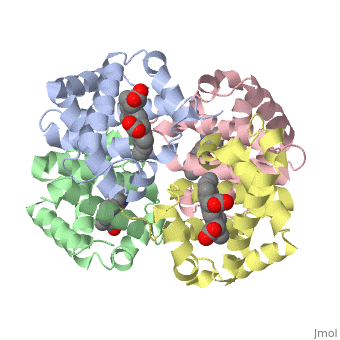Introduction to protein structure
From Proteopedia
(Difference between revisions)
m |
|||
| Line 93: | Line 93: | ||
The overall dihedral angles in a protein can be displayed in a <scene name='57/575866/Ramachandran/1'>Ramachandran plot</scene>, which graphs the interrelationship between phi and psi angles. Pink dots are angles found in alpha helices; yellow dots are found in beta sheets, and white dots are found in other regions (either disordered or turns). Mouse over the white dots on the right sides; what amino acids tend to have atypical phi and psi angles? | The overall dihedral angles in a protein can be displayed in a <scene name='57/575866/Ramachandran/1'>Ramachandran plot</scene>, which graphs the interrelationship between phi and psi angles. Pink dots are angles found in alpha helices; yellow dots are found in beta sheets, and white dots are found in other regions (either disordered or turns). Mouse over the white dots on the right sides; what amino acids tend to have atypical phi and psi angles? | ||
| + | |||
| + | ===Turns and loops=== | ||
| + | |||
| + | There are a number of small hydrogen bonded motifs and patterns which are observed regularly. These are described below:<UL> | ||
| + | <LI>'''<scene name='User:James_D_Watson/Structural_Templates/Secondary_structure_betaturn/1'>Beta Turns</scene>''' - originally defined by the one hydrogen bond common to all (an i, i+3 hydrogen bond) but some modern descriptions do not require a hydrogen bond. | ||
| + | <LI>'''Beta Bulge Loops''' - often associated with beta sheets and result from an additional residue being found in one strand. This interrupts the regular hydrogen bonding and causes a distinctive bulge. | ||
| + | <LI>'''Alpha turns''' - the simplest of all motifs and is characterised by one (i, i+4) hydrogen bond. It is found as part of the hydrogen bonding network of alpha helices as well as occurring on its own. | ||
| + | <LI>'''<scene name='User:James_D_Watson/Structural_Templates/Secondary_structure_paperclip/1'>Paperclip/Schellman Motifs</scene>''' - a common motif found at the C-termini of alpha helices which is essentially a reverse turn that breaks the alpha helix out of its cycle. It is characterised by the presence of a left handed residue and two hydrogen bonds: an i, i+3 bond and an i, i+5 bond. | ||
| + | <LI>'''Gamma Turns''' - these rarer type of turns are characterised by an (i, i+2) hydrogen bond, which is rather weak because of the bent geometry involved. | ||
| + | </UL> | ||
| + | <br> | ||
| + | <br> | ||
| + | <br> | ||
| + | {{Clear}} | ||
| + | |||
| + | |||
| + | ==Motifs In Proteins== | ||
| + | A motif is a super-secondary structure; it describes a set of secondary structures that plays a functional or structural role in a protein. The term is also used to describe a conserved amino acid sequence that characterizes a biochemical function. An example of this is the '''[http://www.ebi.ac.uk/interpro/IEntry?ac=IPR007087 zinc finger motif]''' which is readily identified from the following consensus sequence pattern (where "X" represents ''any'' amino acid):<br/> | ||
| + | |||
| + | '''Cys''' - X<sub>(2-4)</sub> - '''Cys''' - X<sub>(3)</sub> - Phe - X<sub>(5)</sub> - Leu - X<sub>(2)</sub> - '''His''' - X<sub>(3)</sub> - '''His''' <br/> | ||
| + | <br/> | ||
| + | |||
| + | |||
| + | The example structure shown to <scene name='User:James_D_Watson/Structural_Templates/Zinc_finger_highlight/1'>illustrate the motif</scene> is that of Zif268 protein-DNA complex from Mus musculus (PDB entry 1AAY). In this example (a C2H2 class zinc finger) the conserved <scene name='User:James_D_Watson/Structural_Templates/Zinc_finger_cysteine/1'>cysteine</scene> and <scene name='User:James_D_Watson/Structural_Templates/Zinc_finger_histidine/2'>histidine</scene> residues form ligands to a <scene name='User:James_D_Watson/Structural_Templates/Zinc_finger_zn/1'>zinc ion</scene> whose coordination is essential to stabilise the tertiary fold of the protein. The fold is important because it helps orientate the <scene name='User:James_D_Watson/Structural_Templates/Zinc_finger_recognition/1'>recognition helices</scene> to bind to the <scene name='User:James_D_Watson/Structural_Templates/Zinc_finger_major_groove/1'>major groove of the DNA</scene>. | ||
| + | {{Clear}} | ||
| Line 104: | Line 129: | ||
Qu | Qu | ||
</StructureSection> | </StructureSection> | ||
| + | |||
| + | |||
| + | =='''Content Donators'''== | ||
| + | Created with content from [[Structural Templates]] written by [[User:Alexander Berchansky|Alexander Berchansky]], [[User:James D Watson|James D Watson], [[User:Eran Hodis|Eran Hodis]] | ||
Revision as of 13:44, 17 January 2014
Levels of Protein Structure
| |||||||||||
Content Donators
Created with content from Structural Templates written by Alexander Berchansky, [[User:James D Watson|James D Watson], Eran Hodis
Proteopedia Page Contributors and Editors (what is this?)
Ann Taylor, Joel L. Sussman, Alexander Berchansky, Eric Martz, Israel Hanukoglu, Jaime Prilusky, Nick Kenworthy

